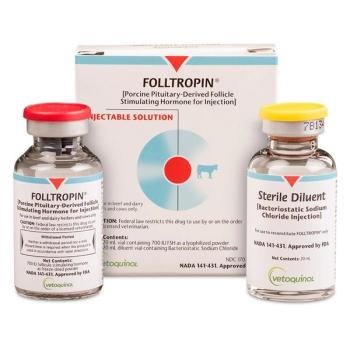
Study shows transfer of feline coronavirus between domestic, wild cats
Researchers made the discovery in tissue from 2 cats that had died in 2008, and say it provides new understanding of the disease
A new study from Cornell University’s College of Veterinary Medicine found genetic evidence of feline coronavirus (FCoV) transmission between captive wild and domestic cats.1,2 Researchers looked back at a potential case of FCoV transmission between a domestic cat and a wild felid more than 15 years ago, using in situ hybridization to analyze frozen tissue samples from both animals. They detected FCoV RNA in different tissues of both felids, proving that FCoV (variant 1) could be transmitted between domestic and wild felids, which extends the known host range of FCoV-1. These findings highlight the importance of identifying the cause of feline infectious peritonitis (FIP), a common, and often lethal, development of FCoV.1,2
There are 2 distinct genotypes of FCoV, classified as types 1 and 2. The genotypes differ in their viral spike (S) protein, which means that the viral molecular mechanisms related to immune evasion, viral tropism, pathogenicity, and host range will not be the same across the genotypes.2 The findings of this study apply specifically to FCoV-1, proving it is transmittable between domestic and wild felids.1,2
“By using a semi-targeted approach—known as hybridization capture—together with next-generation sequencing, we were able to detect and sequence the whole genome of FCoV-1 in both the domestic cat and the Pallas’ cat tissues,” Ximena Olarte Castillo, PhD, postdoctoral associate, first author of the study, said in a Cornell Chronicle article.1 “The main differences between FCoV-1 and FCoV-2 are in highly variable regions. So we need to move from targeting specific genes to whole-genome sequencing, and this technique seems very promising.”
FCoV is a common infection in domestic cats worldwide, and although it typically causes mild or subclinical signs, it’s not uncommon for cats infected with either FCoV-1 or FCoV-2 to develop FIP, which is more severe. There have been reports of FCoV in wild felids, including endangered species, which has been the cause of substantial declines in their populations.2
FIP generally presents as either effusive or non-effusive, more commonly referred to as wet and dry forms, respectively. In the wet form, which is more common, the cat develops excess fluid in the chest or abdomen that interferes with their breathing and general organ function. Cats with the dry form do not develop excess fluid, though they can suffer fever and weight loss in addition to inflammation in various organs, including the liver, kidneys, eyes, and brain. Characteristics of both forms are usually present in all cases, and both forms are eventually fatal.3,4
In November 2008, 2 Pallas’ cat kittens (Otocolobus manul) and a female short-haired domestic cat (Felis catus) shared the same room at a US research facility and all succumbed to FIP. The lung, pleural tissue, and intestine from one of the Pallas’ kittens and the mesenteric lymph nodes of the domestic cat were collected and frozen until they could be analyzed further, pending technological advancements.
Those technological advancements arrived in the form of the NextSeq 1000 sequencer, a next-generation sequencer that determines the order of nucleotides in DNA and RNA. The Cornell Feline Health Center (FHC) recently provided rapid response funding for the technology. Using this, researchers from Cornell analyzed the defrosted tissue to detect FCoV RNA in different tissues of both subjects.1,2
Detection and characterization of FCoV in wild felids has mostly centered on conserved genes, as opposed to the highly variable S gene.1 This means that the genotype causing FIP in most wild felids remains unknown, though researchers emphasized the importance of identifying this genotype in order to develop effective control measures.1
“This study is highly impactful in that it not only provides the first evidence of transmission of FCoV-1 between a domestic cat and a wild [feline], but also because it does so utilizing cutting-edge technology that can be applied to improve surveillance efforts for FCoV and other pathogens in both domestic and wild feline species worldwide,” Bruce Kornreich, DVM, PhD, director, Cornell FHC, said in the Cornell Chronicle.1
Until recently there were no FIP treatments available in the United States. In June 2024,
References
- Hall O. Study proves transfer of feline coronavirus between domestic and wild cats. Cornell Chronicle. September 10, 2024. Accessed September 11, 2024.
https://news.cornell.edu/stories/2024/09/study-proves-transfer-feline-coronavirus-between-domestic-and-wild-cats - Olarte-Castillo XA, Goodman LB, Whittaker GR. Molecular detection using hybridization capture and next-generation sequencing reveals cross-species transmission of feline coronavirus type-1 between a domestic cat and a captive wild felid. Microbiol Spectr. Published online August 19, 2024. doi:10.1128/spectrum.00061-24
- Feline Infectious Peritonitis (FIP). Veterinary Specialty Center. Accessed September 12, 2024.
https://www.vetspecialty.com/feline-infectious-peritonitis-fip/ - Levy J., Hutsell S. Feline Infectious Peritonitis (FIP). Merck Manual Veterinary Manual. August 2018. Accessed September 12, 2024.
https://www.merckvetmanual.com/cat-owners/disorders-affecting-multiple-body-systems-of-cats/feline-infectious-peritonitis-fip - McCafferty C. Compounded oral FIP treatment is now available. dvm360. June 14, 2024. Accessed September 12, 2024.
https://www.dvm360.com/view/compounded-oral-fip-treatment-is-now-available - McCafferty C. Updates in treating FIP. dvm360. August 28, 2024. Accessed September 12, 2024.
https://www.dvm360.com/view/updates-in-treating-fip
Newsletter
From exam room tips to practice management insights, get trusted veterinary news delivered straight to your inbox—subscribe to dvm360.






